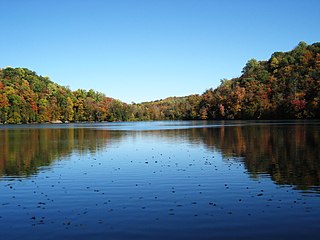
Syracuse is a city and the county seat of Onondaga County, New York, United States. It is the fifth-most populated city and 13th-most populated municipality in the state of New York.

The Village of Hamilton is a village located within the town of Hamilton in Madison County, New York, United States. Notably, it is the location of Colgate University and has a population of 4,239, according to the 2010 census.

Manlius is a town to the east of Syracuse in Onondaga County. As of the 2020 Census, the population was 33,712, making it the third largest suburb in metropolitan Syracuse. In 2005, the town was ranked 98th on CNN's list of Best Places to Live.

Skaneateles is an affluent village in the town of Skaneateles, in Onondaga County, New York, United States. The village is named after, and located on the shores of, Skaneateles Lake, one of the Finger Lakes. As of the 2020 census, the village had a population of 2,533 residents.
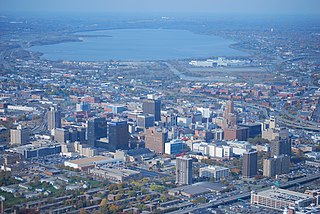
Downtown Syracuse is the economic center of Syracuse, New York, and Central New York, employing over 30,000 people, and housing over 4,300.

The Gridley Building, built in 1867 and known previously as the Onondaga County Savings Bank Building, is a prominent historic building on Clinton Square and Hanover Square in Syracuse, New York, United States. It was designed by Horatio Nelson White and was built adjacent to what was then the Erie Canal and is now Erie Boulevard.
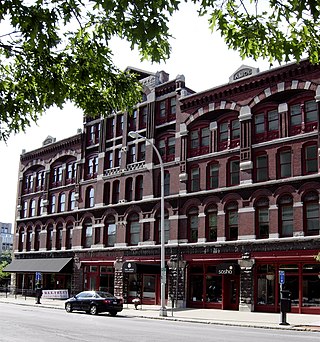
The Amos Block is a Romanesque Revival building located on the southwest corner of Clinton Square in Downtown Syracuse, New York. The building's developer and namesake, Jacob Amos, served as mayor of Syracuse from 1892 to 1896. Originally, the Erie Canal ran directly behind the Amos Block, and goods were loaded and unloaded from the building's upper levels onto the Canal, while the first floor on the West Water St side contained a retail grocer. The building was added to the National Register of Historic Places in 1978.

The Main Street Historic District in Medina, New York, United States, is the downtown commercial core of the village. It is a 12-acre (4.9 ha) area stretching south along Main Street from the Erie Canal to the railroad tracks.
The National Register of Historic Places listings in Syracuse, New York are described below. There are 116 listed properties and districts in the city of Syracuse, including 19 business or public buildings, 13 historic districts, 6 churches, four school or university buildings, three parks, six apartment buildings, and 43 houses. Twenty-nine of the listed houses were designed by architect Ward Wellington Ward; 25 of these were listed as a group in 1996.
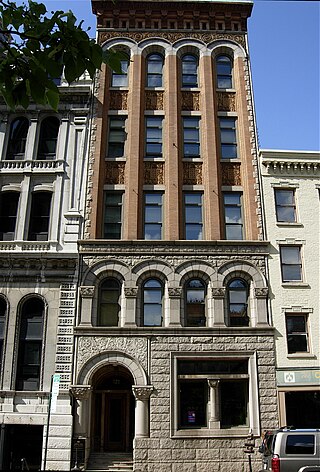
The Gere Bank Building is a five-story building located on Water Street in Syracuse, New York. It was designed by Charles Colton, and built in 1894. It is distinctive for its facade and use of contrasting materials. The cost of the building was $150,000, including nearly $50,000 for fireproof vaults in a room beneath the sidewalk. The building was added to the National Register of Historic Places in 1972. It is part of the Hanover Square Historic District. In the warm weather months, entertainment is common on the plaza around the fountain. Workers in the surrounding office buildings and retail establishments often lunch there.

The Orleans County Courthouse Historic District is one of two located in downtown Albion, New York, United States. Centered on Courthouse Square, it includes many significant buildings in the village, such as its post office and churches from seven different denominations, one of which is the tallest structure in the county. Many buildings are the work of local architect William V.N. Barlow, with contributions from Solon Spencer Beman and Andrew Jackson Warner. They run the range of architectural styles from the era in which the district developed, from Federal to Colonial Revival.
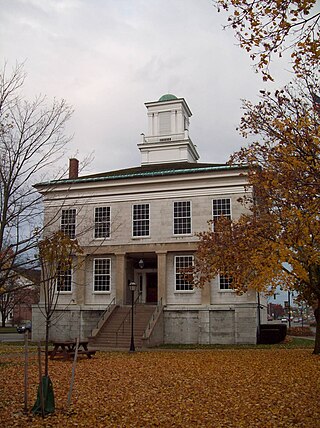
The Genesee County Courthouse is located at the intersection of Main and Ellicott streets in Batavia, New York, United States. It is a three-story Greek Revival limestone structure built in the 1840s.

The Genesee County Courthouse Historic District is located at the junction of Main, West Main and Ellicott streets in downtown Batavia, New York, United States. It is a small area with the county courthouse, a war memorial and other government buildings dating from the 1840s to the 1920s. Some were originally built for private purposes.

The Manlius Village Historic District is a 15-acre (6.1 ha) historic district on the east side of the Village of Manlius, in the Town of Manlius, New York, about 9.5 miles from the downtown of Syracuse.

The State Tower Building is a high-rise building located in Syracuse, New York. Completed in 1928, the building remains the highest in Syracuse. It has around 23 floors and is around 312 feet tall. For several years after the Bastable Theatre burnt down in a 1923 fire, the plot of land was considered as the potential site of a new theatre or an office building. Eventually the plot's owners, Central Offices decided to build an office building. Designed by Thompson & Churchill, work began on the foundation of the State Tower Building in 1927. The tower was completed by late April 1928.
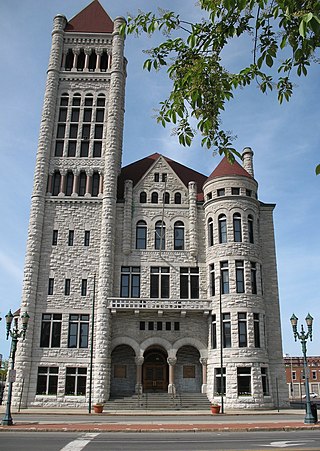
Charles Erastus Colton was an American architect who worked in Syracuse, New York.

Downtown Rochester is the economic center of Rochester, New York, and the largest in Upstate New York, employing more than 50,000 people, and housing more than 6,000.

The Broadway–Livingston Avenue Historic District is located at the junction of those two streets in Albany, New York, United States. It includes seven buildings remaining from an original 20, all contributing properties, and a Warren truss railroad bridge. In 1988 the area was recognized as a historic district and listed on the National Register of Historic Places.

Clinton Square is an intersection in downtown Syracuse, New York, United States. The square was the original town center and first came into existence in the early 19th century where roadways from north and south convened. With the opening of the Erie Canal in 1825 the intersection was further transformed. During the 19th century, the square was a marketplace that also hosted several public events, including an 1870 public barbecue reportedly attended by 20,000 people.






































